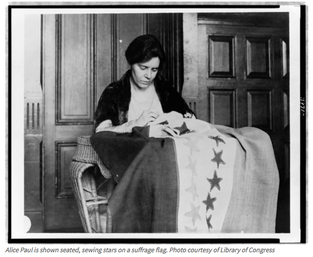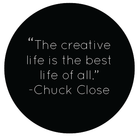 But some suffragists used the imagery of needle arts to further their cause and appear non-threatening to anti-suffragists, who had decried them as "unsexed" and unwomanly. In 1920, after the 19th Amendment passed Congress and suffragists waited for individual states to ratify it, suffrage leader Alice Paul posed on the cover of Suffragist magazine as a modern-day Betsy Ross. Paul "appeared as a domestic archetype: woman seated, wielding just the familiar threaded needle, eyes dropped demurely on the household chore," J.D. Zahniser and Amelia R. Fry wrote in "Alice Paul: Claiming Power." The image projected a non-threatening stance by suffragists, Sapelly said. "It's like communicating, we're not going to stop being women if we get the vote," she said. "We'll still probably be sitting quietly in the sewing room and doing our needlework." Read the entire article here!
1 Comment
|
What's Up?Here, you will find announcements, clarifications, comments and concerns. I frequently post articles about artists, new art blogs, documentaries, and artists that I love! Check regularly as not to be left behind! Archives
June 2017
|
- Home
- Info
-
Projects
- What is art?
- Study Haikus
- Sports in Art History
- Tableaux Vivants
- Timeline
- Create a Podcast/Song >
- Create a Board Game
- Picasso Portraits
- Research Essay
- Storytelling with Music >
- Street Art Socratic Seminar
- Kandinsky Activity
- Greatest Artist Paper
- Museum Gallery
- Museum Visit
- Illuminated Letters >
- Match-maker Activity
- Global Art Dossier
- 250 List
-
Content
- Introduction
- Global Prehistory
- The Pacific
- Indigenous Americas
- The Near East
- Ancient Egypt
- Ancient Greece
- Ancient Etruria
- Ancient Rome
- Late Antiquity >
- Byzantine Art >
- Early Medieval >
- Islamic Art
- Romanesque
- Gothic Architecture
- 14th century Early Renaissance >
- 15th century Renaissance >
- High Renaissance and Mannerism
- Northern Renaissance
- Baroque
- New Spain in America
- Age of Enlightenment
- Early Modernism
- Modernism
- Contemporary Artists
- Africa
- China and Korea
- South and SE Asia
- Japan
- Global Art
- Ethics
- Study
- Educators Only
- Home
- Info
-
Projects
- What is art?
- Study Haikus
- Sports in Art History
- Tableaux Vivants
- Timeline
- Create a Podcast/Song >
- Create a Board Game
- Picasso Portraits
- Research Essay
- Storytelling with Music >
- Street Art Socratic Seminar
- Kandinsky Activity
- Greatest Artist Paper
- Museum Gallery
- Museum Visit
- Illuminated Letters >
- Match-maker Activity
- Global Art Dossier
- 250 List
-
Content
- Introduction
- Global Prehistory
- The Pacific
- Indigenous Americas
- The Near East
- Ancient Egypt
- Ancient Greece
- Ancient Etruria
- Ancient Rome
- Late Antiquity >
- Byzantine Art >
- Early Medieval >
- Islamic Art
- Romanesque
- Gothic Architecture
- 14th century Early Renaissance >
- 15th century Renaissance >
- High Renaissance and Mannerism
- Northern Renaissance
- Baroque
- New Spain in America
- Age of Enlightenment
- Early Modernism
- Modernism
- Contemporary Artists
- Africa
- China and Korea
- South and SE Asia
- Japan
- Global Art
- Ethics
- Study
- Educators Only

 RSS Feed
RSS Feed

